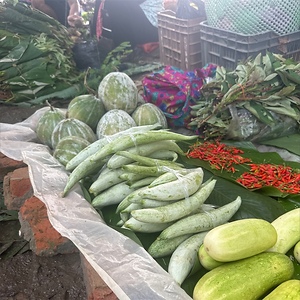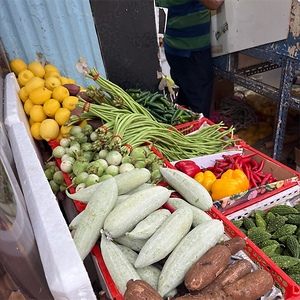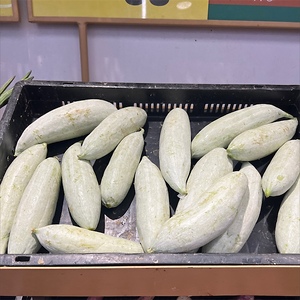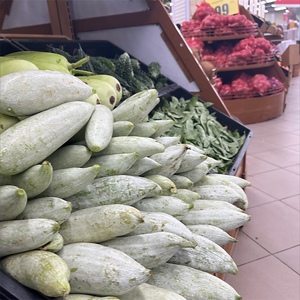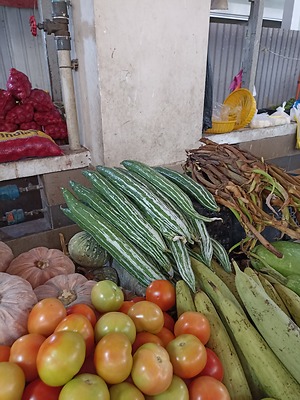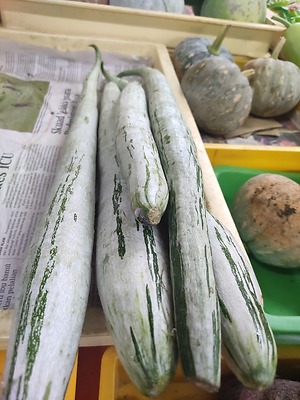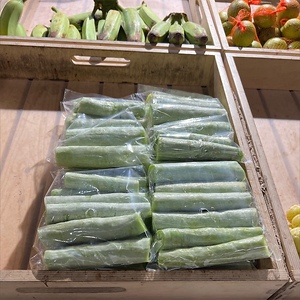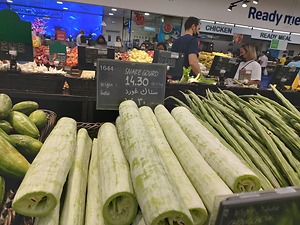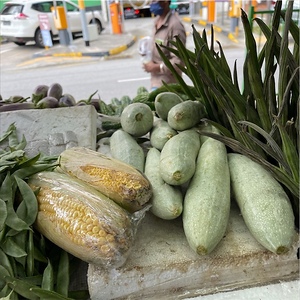


Snake Gourd
Estimated Inventory, lb : 0
Description/Taste
Snake gourds vary in size and appearance, depending on growing conditions and the specific type. The fruits range from short to long in size and can extend 1 to 2 meters in length and 3 to 6 centimeters in diameter. Most Snake gourds are harvested when they have reached 15 to 45 centimeters in length to retain a more tender consistency. The fruits are elongated, slender, and cylindrical with tapered ends and can be straight, curved, or twisted with spirals and coils. Snake gourds are typically divided into green-skinned and white-skinned types. Both types have a waxy, smooth, and lightly textured feel, and some types bear a powdery coating. The fruit’s exterior is firm, taut, and covered in striping and spots. As it matures, it develops an orange-red coloring, and the surface becomes firm, tough, and hard. Underneath the skin, the flesh is green, crunchy, and succulent, bearing few seeds when young. Mature versions will have oblong, hard seeds encased in a gelatinous, paste-like pulp. Some varieties of Snake gourds may release a strange, fishy odor, while other types do not bear an unpleasant scent. Snake gourds are edible raw when young and have a vegetal, green, and mild taste. The flesh softens and becomes tender when cooked, bearing a green-bean-like flavor with subtly sweet nuances. Mature Snake gourds are not commonly consumed as they become bitter and unpalatable.
Seasons/Availability
Snake gourds are available for harvest in tropical climates at multiple points throughout the year. The first yield occurs between April and July, while the second is from August to November.
Current Facts
Snake gourds, botanically classified as Trichosanthes cucumerina, are a category of several fruiting vining plants belonging to the Cucurbitaceae family. The annual vines thrive in humid, tropical, and subtropical climates and extend over 1 to 2 meters in length, climbing over walls, fences, trellises, and the ground. Snake gourds were once localized to their native growing regions in Asia, the Pacific Islands, and Australia, but have since expanded in cultivation to gardens worldwide. The vines produce seasonal fruits that are cooked like vegetables and are distinguishable for their twisting and curling shapes. Snake gourds acquired their name after their ability to coil and curve into shapes resembling serpents hanging from trees. Some growers choose to hang small weights from the bottom of the fruits to help straighten their appearance for markets. Worldwide, Snake gourds are known by many names, including Chachinda, Chichonda, Padwal, Pudalangai, and Pakupis in India, Petola, Patala, Petola Ular in the Malay Peninsula, Ma Noi Ngu and Buap Ngu in Thailand, Gualo and Tian Hua Fen in China, and Karasu-Uri in Japan. The species is also called Serpent Gourd, Snake Melon, Snake squash, Club gourd, Tomato Gourd, Viper Gourd, and Snake Tomato in English-speaking countries. Snake gourds are mostly picked for culinary use when young, small, and still slightly immature. The fruits are harvested 2 to 3 months after sowing, and the plants, in general, are valued by growers for their high yields, ease of cultivation, and versatility. Snake gourds are utilized fresh or cooked and are a mild-flavored ingredient suited for use in savory culinary dishes.
Nutritional Value
Snake gourds vary in vitamin and mineral content, depending on the specific variety. In general, the species is a source of fiber to aid digestion, and vitamins B, C, and E contribute to energy production, strengthen the immune system, and protect the cells against the damage caused by free radicals. Snake gourds also provide minerals like potassium, calcium, and copper. Potassium balances fluid levels within the body, calcium supports bones and teeth, while copper assists in producing red blood cells. In natural medicines across Asia, Snake gourds are used as a cooling ingredient, believed to help lessen fevers, reduce symptoms associated with diarrhea, and remove dampness or heat from the body.
Applications
Snake gourds have a green, subtly sweet, and vegetal taste suited for raw or cooked preparations. Young versions can be chopped fresh and served in salads. Most Snake gourd recipes involve blanching, boiling, or stir-frying. Quick-cooking methods help to retain a crunchy consistency, and the cooked fruits are tossed with aromatics and other flavorings for enhanced taste. In Southeast Asia, Snake gourds are popularly simmered into soups and stews. They are also blanched and eaten with chili paste, deep fried as a crispy snack, or prepared similarly to zucchini. In India, Snake gourds are added to curries, chutneys, stir-fries, dals, and fried into kofta. They are also pickled for extended use as a tangy condiment. Snake gourds are cooked worldwide in a wide array of recipes and are sometimes used similarly to sponge or luffa gourds in East Asia. Popular cooking methods in China include braising, stuffing with pork or seafood, or mixing with salted duck egg in stir-fries. Beyond immature versions, mature Snake gourds have a red-orange pulp that is extracted and used as a substitute for tomato paste in soups, stews, and sauces in Africa. Snake gourds pair well with spices like turmeric, cumin, coriander, and curry leaves, aromatics including onion, chile peppers, and garlic, potatoes, tomatoes, pumpkin, lentils, tofu, and meats such as poultry, pork, and beef. Snake gourds will keep for 10 to 14 days when stored in a sealed container in the refrigerator.
Geography/History
Snake gourds are believed to be native to tropical and subtropical regions of Southern Asia, Southeast Asia, the Pacific Islands, and Northern Australia. The species has been growing wild since ancient times and was thought to have been first domesticated in India. Much of the early history of the species is unknown, but the climbing vines were frequently grown in home gardens for their high yields of edible fruits. Snake gourds were carried from China to Europe sometime in the early 18th century and later spread worldwide as a specialty species. By the late 20th century, the species was extensively cultivated throughout Asia. Today, Snake gourds are still found in the wild in humid forests from sea level to 1,500 meters in elevation. The species is also planted commercially throughout Asia and is grown in home gardens worldwide. Outside of Asia, Snake gourds are present in Australia, Africa, Europe, Latin America, the Caribbean, and the United States. When in season, the fruits are harvested from wild and cultivated vines for sale in fresh markets.
Recipe Ideas
Recipes that include Snake Gourd. One



